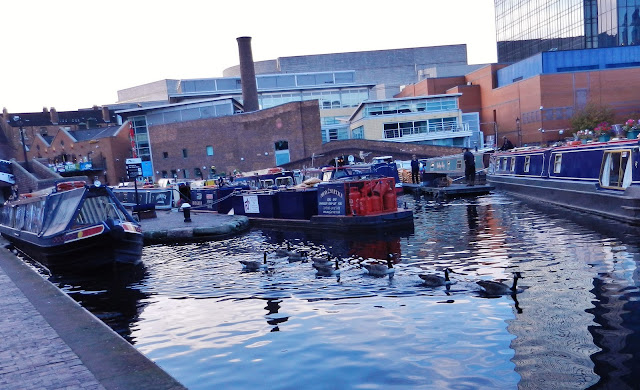On Friday, we left Jan and Steve's house to visit my old neighbour on our way to Birmingham.
Our first house was in Alvechurch, about thirty minutes from the city of Birmingham. It was a semi-detached house, meaning that two houses share a common wall but everything else is separate.
This is me, over fifty years ago.
Here is the house today, barely changed.
Two doors away lived my favourite non-related Aunty Enid and Uncle Ray. As Enid tells it, I loved to spend time at their house and I particularly loved my Uncle Ray.
Ray passed away ten years ago, but Enid still lives in her house, fighting the good fight. She told me that the shed Dad built is still in the back garden of the old house, so I leaned out of her upstairs bathroom window and stole a photo.
We took Enid to lunch at the Red Lion in the village.
While she was getting ready to go, Jeff and I took a stroll up to the top of the road to look at the old canal.
For some reason, canals loom large in my memories of England.
Perhaps it is because of this painting that my Uncle Eddy gave me. It is loosely based on the canal that runs at the top of the road. You can't see it, but he put our names on the barges.
I love this painting.
This is the same canal, looking in the opposite direction.
The canal system in the UK dates back to Roman times, when the waterways were used for irrigation. During the Industrial Revolution they were used for transportation, but were abandoned until recently when they became popular for recreation. Old canals are being reopened and new routes are under construction. Today, there are thousands of miles in the canal network of the UK and you can travel the whole country without ever leaving the water.
This map illustrates the network.
 |
| http://en.wikipedia.org/wiki/Canals_of_the_United_Kingdom |
Pardon my digression.
Back to lunch.
Enid told us stories about my Mum and Dad. She is as lovely as ever, if a little slower on her feet.
After lunch, we went for a little ride around the town and stopped at the old church.
Of course we did! Although I have a personal connection to this one, as I used to attend Sunday School here and also cut through the churchyard on the way to and from school.
As the story goes, Anne and I went to church for a while, but as our parents didn't attend, Anne used to cry for Mum. They eventually told Dad that I could attend but Anne would have to stay home.
This made my Dad really mad and he said neither of us would go.
I can just imagine his ire.
Papa Grizzly.
Locked up tight for the week, like most of the smaller churches.
We said our goodbye to Enid and drove to Birmingham to meet with my cousin, Lynne.
It was, at most, a 35-minute drive.
It took us about two hours.
Can we say Sue hates roundabouts?
When Anne and I were children, we adored our cousin Lynne and couldn't get enough of her. This was cut short by our emigration, of course, and I have only seen her once, just briefly, in the intervening years. So I was very excited to be able to spend some quality time with her.
This is a famous photo in our extended family. We call it "Hear all, see all, and say nowt".
Lynne is the one that isn't blonde!
We finally found her house and I was happy to relinquish all the driving to Lynne.
We went into the city and met up with Richard, her long-time partner.
They both work for a very well-known bank that is close to this old part of the city.
The city of Birmingham has undergone a revival of late and is very hip and up-to-date.
This is the ground level of a big parking structure. How much fun is that?
One of the new buildings.
Lynne knows of my fascination with canals, so everyone indulged me and we walked along the canal before dinner.
It was Friday night and the pace was hopping.
People everywhere, imbibing of relaxing beverages.
The unseasonably warm weather had brought them out in droves.
I can't figure out why more people don't end up in the canal before the end of the night.
This is The Mailbox, which used to be the Royal Mail sorting office for Birmingham City Centre. It was redeveloped and opened as a luxury mixed-use building in 1998. It houses hotels, businesses, retail, and residential facilities. And lots of restaurants that serve relaxing beverages!
Look closely and you will see that the geese are leading the barge.
Richard treated us to a very delicious dinner.
We talked a lot.
And then we went home.
We talked some more.
And then we went to bed.
















































